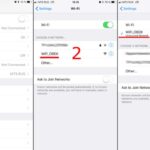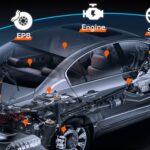Imagine having a direct line of communication with your car’s computer, understanding exactly what’s happening under the hood in real-time. This is the reality with an Obdii Scanner With Wifi, a powerful tool for modern car owners and enthusiasts. These innovative devices provide access to a wealth of data, from engine performance metrics to diagnostic trouble codes, all conveniently transmitted wirelessly to your smartphone or tablet.
What is an OBDII Scanner with WiFi?
OBDII, or On-Board Diagnostics II, is a standardized system in most vehicles built after 1996 that monitors various aspects of a car’s performance and emissions. An OBDII scanner is a device that plugs into your car’s OBDII port, typically located under the dashboard, and retrieves data from the car’s engine control unit (ECU). The “with WiFi” component signifies that this type of scanner transmits the collected data wirelessly over a WiFi network, allowing you to view it on your mobile device without cumbersome cables.
This wireless capability offers significant advantages. Instead of being tethered to the scanner with a cord, you can freely move around the vehicle while monitoring live data. This is particularly useful for dynamic testing, such as observing sensor readings during a test drive or while someone else is operating the vehicle.
Key Features and Benefits of Using a WiFi OBDII Scanner
A WiFi OBDII scanner, especially when paired with a feature-rich app like Car Scanner ELM OBD2, opens up a world of possibilities for vehicle diagnostics and performance analysis:
-
Real-time Data Monitoring: Witness your car’s vital signs as they happen. Create customized dashboards displaying gauges and charts for parameters like engine temperature, RPM, speed, fuel consumption, and sensor readings. This live feedback helps you understand your car’s operation in detail.
-
Access Hidden Data with Custom PIDs: Go beyond the standard data points. Advanced scanners and apps support custom or extended PIDs (Parameter IDs), allowing you to access information that car manufacturers don’t typically make readily available. This deeper level of access can be invaluable for troubleshooting and performance tuning.
-
Diagnose and Reset Fault Codes (DTCs): When your car’s check engine light illuminates, an OBDII scanner becomes your first line of defense. It can read Diagnostic Trouble Codes (DTCs), which pinpoint potential issues. The Car Scanner app, for example, boasts a comprehensive DTC database, providing descriptions of these codes to help you understand the problem. Furthermore, you can often reset these codes after addressing the underlying issue, turning off the check engine light.
-
Freeze Frame Data for Deeper Insights: When a DTC is triggered, the scanner can capture “freeze frame” data. This snapshot of sensor values at the moment the fault occurred provides crucial context, aiding in accurate diagnosis and repair.
-
Mode 06 Testing for Proactive Maintenance: Take advantage of Mode 06 functionality to access ECU self-monitoring test results. This advanced feature allows you to delve into your car’s internal diagnostics, potentially identifying minor issues before they escalate into major, costly repairs.
-
Emission Readiness Checks: Before heading for an emissions test, use your OBDII scanner to verify your car’s readiness. This feature confirms whether all necessary emission system monitors have completed their tests, saving you time and potential headaches at the testing center.
-
Comprehensive Sensor Overview: View all your car’s sensors on a single screen. This consolidated view simplifies the process of checking sensor health and identifying any anomalies or inconsistencies.
-
Broad Vehicle Compatibility: OBDII is a widely adopted standard, meaning WiFi OBDII scanners are compatible with a vast majority of vehicles manufactured from 2000 onwards, and even some from 1996. (Refer to carscanner.info for specific compatibility details). Apps like Car Scanner often include connection profiles optimized for various car brands like Toyota, Mitsubishi, GM, Opel, Vauxhall, Chevrolet, Nissan, Infiniti, Renault, Dacia, Hyundai, Kia, Mazda, Volkswagen, Audi, Skoda, Seat, and BMW, unlocking extra features for these makes.
-
Heads-Up Display (HUD) Mode: For enhanced driving convenience and safety, some apps offer a HUD mode. This projects essential data, such as speed, directly onto your windshield, allowing you to keep your eyes on the road.
-
Performance Measurement Tools: Quantify your car’s performance with built-in acceleration measurement tools. Accurately measure 0-60 mph, 0-100 km/h times, and other performance metrics.
-
Trip Computer and Fuel Efficiency Tracking: Utilize your OBDII scanner as a trip computer, monitoring fuel consumption statistics, distance traveled, and other trip-related data. This can help you optimize your driving habits for better fuel economy.
-
VAG Group Encoding (MQB/PQ26 Platforms): For owners of Volkswagen, Audi, Skoda, and Seat vehicles built on MQB and PQ26 platforms, advanced apps may offer encoding functions. This allows you to customize hidden vehicle parameters, potentially unlocking features or personalizing settings (use with caution and proper research).
Choosing the Right WiFi OBDII Scanner and Adapter
To utilize the benefits of a WiFi OBDII scanner, you’ll need a compatible OBDII adapter that plugs into your car’s diagnostic port and communicates wirelessly. These adapters are often based on the ELM327 chip and are readily available.
Recommended Adapter Brands: While many adapters exist, consider reputable brands like Kiwi 3, Viecar, V-Gate, Carista, LELink, and Veepeak for reliable performance and compatibility.
Beware of Budget Adapters: Extremely cheap OBDII ELM327 adapters, particularly those marked as v.2.1, may have limitations and bugs. While they might function, they can be prone to connection issues, slow data transfer, and in rare cases, even interfere with your car’s electronics. Investing in a quality adapter is recommended for a smoother and more reliable experience.
App Compatibility is Key: Ensure your chosen OBDII scanner and adapter are compatible with your preferred OBDII app, such as Car Scanner ELM OBD2. Check the app’s documentation or compatibility lists for recommended adapters.
Conclusion: Empowering Car Owners with Data
WiFi OBDII scanners have revolutionized car diagnostics and performance monitoring, putting powerful tools directly into the hands of car owners. By providing wireless connectivity and access to a wealth of vehicle data, these scanners, coupled with user-friendly apps like Car Scanner ELM OBD2, empower you to understand your car better, diagnose issues effectively, and potentially save money on maintenance and repairs. Explore the possibilities of OBDII scanning and unlock your car’s hidden secrets today.


